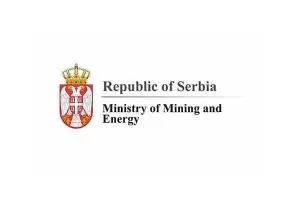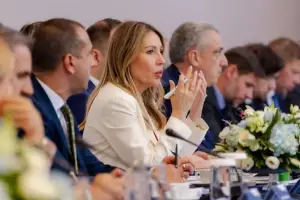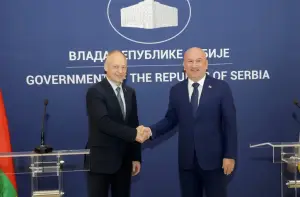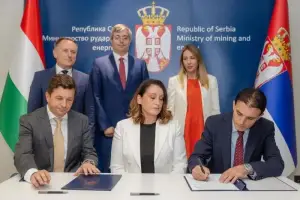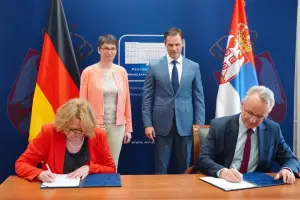Q:
A:
Foreign trade increases in first six months by more than 20%
Belgrade,
31 July 2006
The Serbian Statistical Office stated today that Serbia's overall foreign trade in the period from January to June 2006 totalled $8,301.6 million, up 22.2% compared to the same period in 2005.
Expressed in euros, foreign trade reached €6,744.6 million, which is an increase of over 27.4%% against the same period last year.
Exports stood at $2.508.1 million, up 18.9% compared to the same period last year, while imports totalled $5,793.5 million, a 23.6% increase in relation to the same period in 2005.
Expressed in euros, exports jumped 24.1% to €2.037 million, while imports went up 28.9% to €4,707.5 million in relation to the same period previous year.
Exchange of goods with Montenegro in the period from January to June 2006 was worth €265.2 million, with exports in the amount of €206.6 million and imports €58.7 million. If trade with Montenegro is included in Serbia’s foreign trade then expressed in euros it would be worth €7,009.8 million.
Exports would be worth €2,243.7 million, representing an increase of 24.9% in comparison with the same period last year, and imports €4,766.2 million, up more than 28.2% against the same period in 2005, while the trade deficit expressed in euros would stand at €2,522.5 million.
Increased imports in the past six months were a result of the import of energy sources. Namely, the import of gas, oil, electricity, coke, butane and diesel in the first six months stood at $981 million, making 21% of the total import.
Furthermore, the increase is also due to copper and iron ores import ($158 million), which are used in the production of elementary and other metals, since at this moment the prices of these ores are favourable.
Increased demand (public and private spending) also bore influence on the rise in imports. The increased availability of loans resulted in the increase of demand, which in turn affected the import. This is confirmed by the fact that the import of road vehicles in the period January-June was $428 million, which is 9.2% of the total import.
Increase in export is a result of privatisation and restructuring of privatisation, and signed and ratified agreements on free trade with countries signatory to the Stability Pact.
Increased exports are a result of trade surplus in exchange of food products (export of bread-grain and bread-grain products worth $104 million, in which corn was $71 million, sugar $88 million).
Trade surplus in the import of ready-made textile goods also played a role in increase in exports, thanks to the agreement signed with the EU and preferential status of Serbian goods, as well as by an increase in world prices of basic metals and general economic activity.
The trade deficit for the period January-June 2006 stood at $3,285.4 million, up by 27.5% against the same period last year. Expressed in euros, the deficit stood at €2,670.4 million, up by 32.8% against the same period in 2005.
Expressed in dollars the exports-to-imports ratio was 43.3%, showing a fall against the same period last year, when it stood at 45%. Expressed in euros, the ratio was 43.3%, whereas last year it was 44.9%.
The most exported items in the period January-April 2006 were intermediate goods accounting for 69.2% ($1,736 million), followed by consumer goods, which made up 25.6% ($642 million) and equipment, making up 5.2% ($130 million) of total exports.
Imports were dominated by intermediate goods accounting for 63.5% ($3.681 million), followed by consumer goods, 21.5% ($1.247 million) and equipment, 14.9% ($866 million).
Major importers of goods from Serbia were Italy ($423.9 million), Bosnia-Herzegovina ($314.3 million) and Germany ($273.1 million). The largest exporters to Serbia were Russia ($979.3 million), Germany ($549.4 million) and Italy ($492.4 million).
The greatest foreign trade was recorded in commerce with the EU, which accounted for more than half of total trade. The foreign trade surplus realised in commerce with Bosnia-Herzegovina was $177 million, whereas with Italy the foreign trade is more balanced than last year.
Thanks to the free trade agreement, as well as the competitiveness of Serbian products, a surplus was also achieved in commerce with Macedonia, but the largest deficit remained in commerce with Russia, due to energy imports, mainly oil and natural gas.
According to Standard International Trade Classification (SITC) most exported items are iron and steel ($369 million), coloured metals ($264 million), garments ($136 million), various ready-to-use products ($111 million) and India-rubber products ($111 million), and export in these five sections made up 39.5% of overall exports.
The top five sectors with largest imports are oil and oil derivatives ($757 million), road vehicles ($428 million), natural and industrial gas ($340 million) industrial machines for general use ($270 million) and electric machines, apparatus and equipment ($220 million), and imports of these articles comprises 34.8% of total imports.
Exports stood at $2.508.1 million, up 18.9% compared to the same period last year, while imports totalled $5,793.5 million, a 23.6% increase in relation to the same period in 2005.
Expressed in euros, exports jumped 24.1% to €2.037 million, while imports went up 28.9% to €4,707.5 million in relation to the same period previous year.
Exchange of goods with Montenegro in the period from January to June 2006 was worth €265.2 million, with exports in the amount of €206.6 million and imports €58.7 million. If trade with Montenegro is included in Serbia’s foreign trade then expressed in euros it would be worth €7,009.8 million.
Exports would be worth €2,243.7 million, representing an increase of 24.9% in comparison with the same period last year, and imports €4,766.2 million, up more than 28.2% against the same period in 2005, while the trade deficit expressed in euros would stand at €2,522.5 million.
Increased imports in the past six months were a result of the import of energy sources. Namely, the import of gas, oil, electricity, coke, butane and diesel in the first six months stood at $981 million, making 21% of the total import.
Furthermore, the increase is also due to copper and iron ores import ($158 million), which are used in the production of elementary and other metals, since at this moment the prices of these ores are favourable.
Increased demand (public and private spending) also bore influence on the rise in imports. The increased availability of loans resulted in the increase of demand, which in turn affected the import. This is confirmed by the fact that the import of road vehicles in the period January-June was $428 million, which is 9.2% of the total import.
Increase in export is a result of privatisation and restructuring of privatisation, and signed and ratified agreements on free trade with countries signatory to the Stability Pact.
Increased exports are a result of trade surplus in exchange of food products (export of bread-grain and bread-grain products worth $104 million, in which corn was $71 million, sugar $88 million).
Trade surplus in the import of ready-made textile goods also played a role in increase in exports, thanks to the agreement signed with the EU and preferential status of Serbian goods, as well as by an increase in world prices of basic metals and general economic activity.
The trade deficit for the period January-June 2006 stood at $3,285.4 million, up by 27.5% against the same period last year. Expressed in euros, the deficit stood at €2,670.4 million, up by 32.8% against the same period in 2005.
Expressed in dollars the exports-to-imports ratio was 43.3%, showing a fall against the same period last year, when it stood at 45%. Expressed in euros, the ratio was 43.3%, whereas last year it was 44.9%.
The most exported items in the period January-April 2006 were intermediate goods accounting for 69.2% ($1,736 million), followed by consumer goods, which made up 25.6% ($642 million) and equipment, making up 5.2% ($130 million) of total exports.
Imports were dominated by intermediate goods accounting for 63.5% ($3.681 million), followed by consumer goods, 21.5% ($1.247 million) and equipment, 14.9% ($866 million).
Major importers of goods from Serbia were Italy ($423.9 million), Bosnia-Herzegovina ($314.3 million) and Germany ($273.1 million). The largest exporters to Serbia were Russia ($979.3 million), Germany ($549.4 million) and Italy ($492.4 million).
The greatest foreign trade was recorded in commerce with the EU, which accounted for more than half of total trade. The foreign trade surplus realised in commerce with Bosnia-Herzegovina was $177 million, whereas with Italy the foreign trade is more balanced than last year.
Thanks to the free trade agreement, as well as the competitiveness of Serbian products, a surplus was also achieved in commerce with Macedonia, but the largest deficit remained in commerce with Russia, due to energy imports, mainly oil and natural gas.
According to Standard International Trade Classification (SITC) most exported items are iron and steel ($369 million), coloured metals ($264 million), garments ($136 million), various ready-to-use products ($111 million) and India-rubber products ($111 million), and export in these five sections made up 39.5% of overall exports.
The top five sectors with largest imports are oil and oil derivatives ($757 million), road vehicles ($428 million), natural and industrial gas ($340 million) industrial machines for general use ($270 million) and electric machines, apparatus and equipment ($220 million), and imports of these articles comprises 34.8% of total imports.

